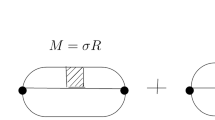Abstract
In our letter we establish coupling of the effective Heisenberg–Euler Lagrangian on the order of 1/m4 and the Chiral Magnetic Effect known for a massless particles. We consider a generalization of the effective Heisenberg–Euler Lagrangian from QED to QCD and then calculate the induced vector current. Further, considering the vector current, we establish a method to connect the perturbative result with the Chiral Magnetic Effect. We formulate the rule of transit from perturbation to nonperturbation (formula (5)) and obtain the well-known result for a massless particles.
Similar content being viewed by others
REFERENCES
K. Fukushima, D. E. Kharzeev, and H. J. Warringa, “Chiral magnetic effect,” Phys. Rev. D 78, 074033 (2008).
D. E. Kharzeev, “The chiral magnetic effect and anomaly-induced transport,” Prog. Part. Nucl. Phys. 75, 133 (2014).
D. E. Kharzeev, K. Landsteiner, A. Schmitt, and H.‑U. Yee, “Strongly interacting matter in magnetic fields,” Lect. Notes Phys. 871, 1–624 (2013).
M. S. Abdallah et al. (STAR Collab), “Search for the chiral magnetic effect with isobar collisions at √SNN = 200 GeV by the STAR Collaboration at RHIC,” arXiv: 2109.00131 [hep-ph] (2021).
K. Fukushima, D. E. Kharzeev, and H. J. Warringa, “Real-time dynamics of the chiral magnetic effect,” Phys. Rev. Lett. 104, 212001 (2010).
Y. Hirono, T. Hirano, and D. E. Kharzeev, “The chiral magnetic effect in heavy-ion collisions from event-by-event anomalous hydrodynamics,” arXiv: 1412.0311 [hep-ph] (2015).
V. V. Skokov, A. Yu. Illarionov, and V. D. Toneev, “Estimate of the magnetic field strength in heavy-ion collisions,” Int. J. Mod. Phys. A. 24, 5925 (2009).
H. J. Warringa, “Dynamics of the chiral magnetic effect in a weak magnetic fields,” Phys. Rev. D 86, 085029 (2012).
V. Domcke, Y. Ema, and K. Mukaida, “Chiral anomaly, Schwinger effect, Euler–Heisenberg Lagrangian and application to axion inflation,” J. High Energy Phys., No. 02, 055 (2020).
O. V. Teryaev, “Axial anomaly for hadrons and QCD matter,” Nucl. Phys. B Proc. Suppl. 219–220, 86–93 (2011).
W. Heisenberg and H. Euler, “Consequences of Dirac’s theory of the positron,” Z. Phys. 98, 714 (1936).
G. V. Dunne, “Heisenberg-Euler effective lagrangians: Basics and extensions,” in From Fields to Strings: Circumnavigating Theoretical Physics, Ian Kogan Memorial Collection, Ed. by M. Shifman, A. Vainshtein, and J. Wheater (World Scientific, Singapore, 2004), p. 445.
Author information
Authors and Affiliations
Corresponding author
Rights and permissions
About this article
Cite this article
Teryaev, O.V., Shohonov, D.A. Chiral Magnetic Effect and the Heisenberg–Euler Lagrangian. Phys. Part. Nuclei Lett. 19, 317–319 (2022). https://doi.org/10.1134/S1547477122040203
Received:
Revised:
Accepted:
Published:
Issue Date:
DOI: https://doi.org/10.1134/S1547477122040203




